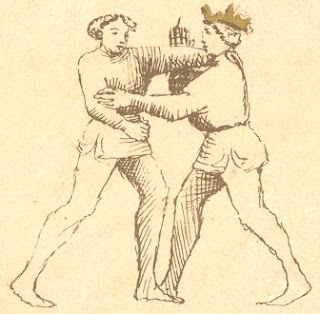
I spent pretty much the entire class working on the first three plays of abrazare with the beginners tonight. The beginner's course per se officially finished tonight but those remaining were invited to carry on training for free in the 4 or so sessions we've left before the Christmas break. So I thought, sod it, at least they'll get to see a version of the first three plays done in one setting.
First Play
Based on the experiences and mini-aha! moment, I had them go with the chambered gut punch attack, with the defender in porta di ferra, right foot forward. The attacker attacks and the defender steps with an accressere fora di strada, turning a little anticlockwise to face at about 45 degrees to their original direction, while stopping the punch, striking (carefully) the elbow to get it straight and driving the right hand up to chingiale, making the attacker's elbow roll upwards. Some things we noticed compared with the last time:
- Stepping straight backwards does give the attacker time and space to avoid the strike and if the attacker really goes for a shoulder or neck grab prior to punching, it makes the reaching arm pull straight, thereby making for an easier hyperextension of the elbow made by striking it and trapping the hand aganst the defender's neck.
- If however, the reaching movement is tentative and the defender steps backwards, the attackers hand may be simply beaten away in front on the defender's neck. This is not necessarily bad in itself, as it may open to another play, like a ligadura mezana, or turning the attacker enough to enter and go for a headlock or a full nelson (eleventh play).
- stepping offline diagonally forward ensures that the reaching arm is trapped against the defenders neck, giving a point of leverage against which the elbow may be hyperextended.
- if you step straight forwards or back, the initial strike to the elbow usually comes straight up. This can make the initial straightening of the elbow joint difficult. If though, you step with the accressere fora di strada (afds) and pivot, you can strike the elbow in a more horizontal motion, straightening the elbow joint, before continuing the upward movement into the chingiale shown in first play, simultaneously rolling the attacker's elbow upwards.
- stepping with afds and a pivot takes the defender's body away and offline from the attacker's strike, while allowing the defender to counterattack to the outside of the attacker's knee joint or thigh with the defender's own knee. This aids in breaking the attacker's structure as well as providing an extra contact point to allow the defender to feel how the attacker may react. The other two points of contact are on the crook of the attacker's striking arm and the hyperextended reaching arm, as shown in first play.
The Second PlayFollowing on from first play the defender, having straightened and rolled the attackers elbow, drops his hand vertically, gripping the wrist with his other hand, to help maintain the hyperextension. From here he can kick out his front foot and drop his entire body weight on the straight arm, pivoting from the hip. That Fiore doesn't explicitly show this suggests to me that this is a training manual and underlines the concept of friendly training, abrazare di amore. We take the technique to a safe point and stop, aware of our training partner's limits.
Things to note:
- the defender is working on the elbow joint of the attacker, not his shoulder. If he tried to work on the latter, the defender could more easily resist.
- the defender looks at his opponent all the time. This allows him to trap the hand of the attacker under his jaw, a bit like a violin player "holds" a violin. This is particularly useful in class if the attacker has small hands which just seem to always slip out when practicing this play.
- the defender's back is very straight. He doesn't bend from the waist when making the attacker "kiss the ground", he keeps his back straight dropping his weight by bending from the knees (in the training non-violent version).
- as the defender, the students often seem to want to pull their hands into their body, often with a volta stabile, trapping the attacker's arm straight along their body. Seems to be doable, as long as they maintain control of the attacker's hand(see bove), keep their backs straight and that they power the volta stabile from the hips not the arms. The hands should move first of course, back to porta di ferra mezzana.
- a small detail but important. A "play" seems to be an action done in response to something else, i.e. He does this, I do that, but if he does that, then I counter with this. Fiore shows numbered plays that may flow from one into the next, as plays 1, 2 and 3 seem to do. But they can flow in a seemingly random order also, they don't HAVE to go like this. I think he shows the first three in this order to show precisely this point, that the plays should flow from one to the next and that he uses the optimum play to show what can be done when faced with a certain type of action. For example, I could just have easily done play eight from the initial attack as play one. Alternatively, if I screwed up the first play and didn't manage to get the elbow straight to do a hyperextension, I might get the chance to continue by immediately trying for play eight instead, striking under the ear of the opponent. This is just my opinion and I'm open to correction.

Hell, it's late! I'll continue this tomorrow as I'm too knackered to keep writing.
No comments:
Post a Comment